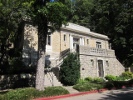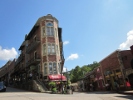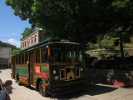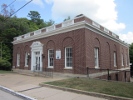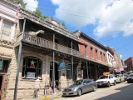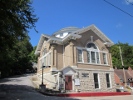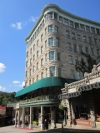Eureka Springs, AR - Carroll County
"From my first walk in the town that would become my home, how moving and timeless the narrow street seemed, curving uphill, with its Victorian stone buildings." ~ Crescent Dragonwagon, 1997History of Eureka Springs
Eureka Springs is often referred to as the "city that water built". Long before the arrival of white settlers and healthseekers, the curative properties of the "healing springs" were well known to numerous Native American tribes. Ancient Indian hieroglyphs discovered at nearby Blue Spring suggest that as many as 14 different tribes resided in the area at one time or another. Tribes from the East, including the Cherokee and Sioux, also told tales of the magical healing waters west of the Mississippi. Historians have even speculated that the "Fountain of Youth" that Ponce De Leon had searched for may have been the Basin Spring that now sits at the heart of downtown Eureka Springs.
Naming Eureka Springs
Not until about 1856 would an enterprising doctor by the name of Alvah Jackson discover the old "Indian Healing Spring" while camping with his son. Dr. Jackson, an Oxford graduate from London, had been an M.D. and surgeon in New Orleans before moving to Kentucky. He arrived in Carroll County with his family in 1832, settling first in the historic community of Shady Grove. He had heard the legend of the miraculous Indian healing springs, and had searched for some time before locating them. He first used the waters from the spring to cure an eye infection that his son had been struggling with. He began to bottle and market the spring water as "Jackson's Eye-Water", and the legend of the miraculous healing springs in the Arkansas Ozarks soon spread throughout the frontier. Jackson later brought Judge L.B. Saunders to the spring site, and the judge would move his family there in the summer of 1879. His son Burton "Buck" Saunders built the family a rough frame house, considered by many to be the first permanent settlement in Eureka Springs. Buck would also be credited with the naming of the spring. Legend has it that the judge suggested the spring be named "Jackson Spring" in honor of his friend's discovery, but Alvah Jackson instead offered "Saunders Springs". Buck reportedly broke the tie with "Eureka" - meaning "I've found it!" The spring itself would later become known as the "Basin Spring" due to a depression that had been hand-carved into the rock by Indian visitors from long ago. But the town would retain the name that Buck Saunders proclaimed that day - "Eureka" Springs.
Early Development
Eureka Springs is located in an area ceded to Carroll County in 1869 to increase the size of the county to a minimum 600 square miles. By July of 1879, the first general store was built by O.D. Thornton. A month later, 15 homes had been built, and the town boasted a population of 180 people. An additional general store opened, soon followed by a meat market, blacksmith shop, lumber yard, drugstore, hardware store, tailor, and liquor store. A man named H.S. Montgomery cleared the trees for the new "Main Street". The first newspaper in town was called The Eureka Springs Herald and was started by a man named Hinman in 1875. The first tragic death was recorded in town on August 8, 1879, when the wife of Professor Isaac A. Clarke, of the immensely popular Clarke Academy in Berryville, was killed by a falling tree during a family picnic. On that same day, the first town committee was elected. The Post Office of Eureka Springs was first established on October 21, 1879. Historic records indicate that it was located near the present day intersection of HWY 23 and HWY 62. The first person to serve as the Eureka Springs postmaster was a man named Aaron W. McCarty. The Masonic "Basin" Lodge #386 in Eureka Springs was organized in 1881 by former members of the Berryville Masonic "Ashley" Lodge #66. It remains active today, with Lodge Headquarters located in a brick building off of East Mountain, on Harvey Road. The Independent Order of Odd Fellows (I.O.O.F) Lodge # 83 in Eureka Springs was instituted on March 24, 1881. It was later consolidated with Berryville Lodge # 82 in 1973.
The town of Eureka Springs was officially incorporated on February 14, 1880. The first banking institution was the John H. Cameron & Co. Banking House, established in 1881. The first Medical Society in Carroll County was also organized in Eureka Springs in 1881, but was short-lived. It disbanded only a few years later. The first musical band was organized in 1886 by a local druggist named Mr. Brim. By the 1890's the sprawling town had its own hardware stores, grocery stores, general merchandise stores, clothing stores, dentist, livery stables, law offices, drugstore, newspaper, bank, confectionery shop, livestock dealers, harness and saddle shop, and sewer system.
The Great Land Dispute
News of the healing springs brought thousands of health-seekers to the area, and by April of 1880, there were an estimated 15,000 people roaming the hills with walking stick and drinking cup in hand. The town soon appointed Mr. I.N. Armstrong as town surveyor. Starting at the reservation around the Basin Spring, his survey was completed in the winter of 1880. The town was developing around four primary locations - the Basin Spring, Harding Spring, an area north of Harding Spring called "Evansville", and an area south of town near Johnson and Oil Springs. It was soon discovered that Armstrong had been taking payments and assigning the same lots to multiple claimants. He soon left town. In addition to the multiple squatters that were vying for lots, a number of redundent claims had also been submitted to the county land office for agricultural, mineral, and timber rights in Eureka Springs. One such claim, from the "Blue Springs Mineral Company" even tried to file claims on the mineral rights of all the springs in town. Miners soon arrived in town and began drilling near the springs, much to the dismay of the squatters and health-seekers. Fights ensued, and the mayor was impeached. The land disputes were escalated to the county land commissioner, U.S. Secretery of the Interior, and even the federal courts, but the claimants would not see any form of resolution until the new mayor John Carroll offered a compromise in 1885.
It was decided that all reserved springs would remain the property of the city. Churches received their land for free, and squatters would receive their deeds. Lumber barons (and one infamous baroness) had already removed much of the old growth timber from the area, and had moved on. The Eureka Improvement Company, which had been formed by Powell Clayton upon his arrival in 1882, would receive all unclaimed property, and was awarded a franchise to operate the city's street cars, gas and water utility lines for 50 years. Clayton was a Union army general, engineer, and had served as the first "carpetbag" Governor of Arkansas during reconstruction. This likely brought him little favor with the agrarian "hill-folk" in eastern Carroll County, so it should come as no surprise that he soon used his political influence to establish a separate Western Judicial District in Carroll County.
The Eureka Improvement Company
It is difficult to fully comprehend the influence that the Eureka Improvement Company had on the town of Eureka Springs when it began to market the town as a luxury resort for the ultra-rich. The "crazy-quilt" of dirt footpaths, rough wooden shacks, and squatters' tents that seemed to sprout overnight would soon give way to an elegant Victorian "city of the first class". Elaborate boardwalks, gazebos, and "stair-steps" were constructed to connect the various springs and popular lodging establishments. Extensive stone retaining walls were built, and the overall level of Main Street was raised to alleviate frequent run-off problems that had earned it the unfavorable nickname of "Mud Street". A bandshell was constructed at the Basin Park in 1915, where visitors were treated to grand musical performances. Many of these improvements were the result of a group of civic-minded Northerners operating under the beneficial patronage of the Eureka Improvement Company, led in part by Powell Clayton and a wealthy Irish immigrant named Richard Kerens.
Richard C. Kerens first arrived in town in 1881, with plans to assess a possible railroad connection. He was a Union Army veteran, and a very influential Republican politician. When Powell Clayton arrived in Eureka Springs in 1882, he and Kerens were quick to join forces to create the Eureka Improvement Company, establishing numerous public utilities and "modern" improvements within the city. Exercising their political influence, they also brought the first passenger train to Eureka Springs, arriving at a new wood-framed depot on January 24, 1883. Kerens would also be instrumental in the building of the Crescent Hotel in 1886, at a cost of $300,000, and he would later build the Kerens Memorial Chapel in honor of his mother. Today, it is known as St. Elizabeth's Catholic Church. He also donated the land for the Eureka Springs Carnegie Public Library, which was completed in 1912. The Eureka Improvement Company would later change its name to "The Syndicate Company", but it would never be quite as influential as it was in those early years at the close of the 19th century.
Early Education in Eureka Springs
Prior to the 1890's, schools in Eureka Springs were relatively unorganized. Classes were held in various commercial buildings and homes throughout town, and as a result the schools saw considerable fluctuation in enrollment. The general transient nature of much of the population also contributed to irregular enrollment figures. Historical records indicate that the first high school commencement occured in 1890 at the Eureka Opera House, with only 2 students graduating. One of the earliest structures to be built as a dedicated schoolhouse was a one-room building located at the entrance to Mill Hollow in the 1880's. A 3-story public school building known as the "Soldier School" was then constructed in 1881 on East Mountain near Soldier Spring. The Comer School was built on Prospect Avenue. Today, it houses St. James Episcopal Church, the oldest church congregation in Eureka Springs. Other early schools include the Lamar School, Clay Street Public School just south of town, the Owen Street School west of Elk Street, and the Benton Street School off of Main Street. There was also a public "Negro" school in German Alley for the resident black population at the time. It was located near the present day site of the Perkins Lumber Company.
A new chapter in the history of Eureka Springs public education would begin on September 3, 1892. On this day, the W.H. Reid Public School opened off of Prospect Avenue. Reid was the vice president of the Illinois Trust and Savings Bank, and a frequent visitor to the resort town, and he graciously donated $25,000 for the construction of this "first class" school building that would affectionately earn the nickname of "Old Red Brick School". The school featured its own library, laboratory, school garden, and a large playground. Enrollment reached about 700 students annually, and the school served all grades of children until a contemporary school was built on HWY 62 in 1951. The "Old Red Brick" then operated as a bed and breakfast for several years until it was destroyed by a lightning-related fire in 1988. Today, only the stone basement level and some scattered bricks and steps remain of this memorable institution.
Eureka Springs would see its first college established in the popular Crescent Hotel. The Crescent College for women opened on September 23, 1908 and would remain in operation until 1924.
Railroads and Automobiles in Eureka Springs
By the beginning of the 20th century, medical science had begun to debunk the claims of the healing springs, and the effect was being felt across the continent in the once popular "health resorts". Eureka Springs was no exception. By 1902, the Crescent Hotel was being leased to the Frisco Railroad in an effort to change gears and promote the town for rail travel. A tunnel had been blasted through the mountains to the East, and the line had been extended to Harrison. A new stone depot was erected in 1913, but the town had already suffered a serious financial blow when the railroad decided to remove their shops in 1911. The popularity of rail travel was, however, quickly being replaced by that of the automobile. The first automobile had arrived in Eureka Springs in 1906. The railroad was in receivership by 1912, and was government run from 1918-1920. A violent workers strike began in 1921 and resulted in murder before it ended in 1923. The 3-mile streetcar track through town, which began as a horse-drawn operation in 1891, had been electrified by 1898, but was discontinued in 1923 to make room for motorists in the street. Extensive auto highways were cut through the Ozarks in the 1920s, and new "motor camps" began to spring up along HWY 62, which was paved in 1933.
Early Communication
The first telephone system in Carroll County was established in 1895 in Eureka Springs by the J.W. Hill Telephone Company. An 20-year franchise awarded to J.W. Hill and C.B. Wright in 1894 stipulated that the city would receive free telephone service as part of the agreement. As the operator of the Crescent Hotel's livery stables, Hill was no stranger to the town, and quickly set to work building the cutting edge communications system in a small home on Hillside Avenue near the livery stables. The initial switchboard could handle 25 lines with Mae Starr Miller serving as the first operator. The first lineman, Sam Richardson, kept things in working order. By 1896, the system had grown to 105 subscribers, which would more than double by 1899.
When J.W. Hill died in 1902, his sister took over and operated the company for seven years. Then in 1909, the business was sold to the Southern Telephone Company and the central office was relocated to the town's Masonic Lodge. Two years later, Eureka's telephone company was sold to the Southwest Telephone and Telegraph Company who moved all central office equipment to the Hawley Building when a fire ravaged the Masonic Lodge in 1913. In June of 1939, the telephone exchange was converted to dial operation with about 350 subscriber lines.
Land of a Million Smiles
On November 25, 1919 the "Ozarks Playground Association" was formed in Eureka Springs. The association was a marketing tour de force that attempted to breathe new life into the area by playing upon the national ferver of a popular Ozark novel titled Shepherd of the Hills. Written in 1907 by Harold Bell Wright, the Ozark-based novel reportedly sold over a million copies and quickly drew the eyes of the nation. Consequently, the Ozarks Playground Association began to market the Ozarks as the "Land of a Million Smiles", and tourism grew steadily each year. Like so many others before him, Wright had first come to the Ozarks for health reasons. His story tells an exaggerated tale of the mountain dwellers he met while visiting, and of their agrarian customs and the fascinating "arrested frontier" they inhabited. In time, numerous tourist-based cities in the Missouri and Arkansas Ozarks would credit much of their economic growth to this one novel. It would later be translated into seven different languages and inspire a Hollywood film starring John Wayne.
The Artist and Writer Mecca
Like much of the nation, the Great Depression had a devastating effect on many of the citizens of Carroll County. Eureka Springs may have built a brand new Auditorium in 1928, but enticing pleasure-seeking guests would prove to be a challenge while so much of the country was struggling for such basic needs as food and shelter. Fortunately, the small town soon attracted the attention of artists and writers who managed to infuse the town with new life in such dark times. Prominent local writers such as Vance Randolph, Frank L. Beals, Marge Lyon, Cora Pinkley Call, and Otto Ernest Rayburn would soon pick up where Harold Bell Wright had left off with his popular Ozark classic titled Shepherd of the Hills, further exposing the magic of the Ozark people and their homeland to the rest of the world. Active early artists in the scene included Louis and Elsie Freund, Lester Exley, Virginia Tyler, Art Foster, Verne Stanley, and Bonnie Lela Crump. In 1931, a new "bridge studio" for artists and writers was constructed across a ravine at Camp Leath by owners Sam Leath and Steele Kennedy. The structure was an interesting enterprise and was met with much fanfare, but was short-lived, being torn down in the mid-thirties when Camp Leath was sold to new owners.
Dr. Baker's Phoney Cancer Hospital
In 1937, the neglected historic limestone structure of the Crescent Hotel was sold to Norman Baker, an ex-vaudeville magician, controversial radio personality, and false cancer doctor from Muscatine, Iowa. After leaving a trail of victims to his false cancer cures in Iowa and New Mexico, he eventually made his way to Eureka Springs and turned the Crescent Hotel into the Baker Hospital. Historians estimate that he was bringing in as much as $500,000 a year before the federal government cracked down on him in 1940. He was tried in Little Rock, and sentenced with seven counts of fraud. Investigators found that the bogus "treatments" that Baker had administered had actually hastened the death of most patients, while denying them of proper medical treatments that may have saved their lives. Baker later offered the property to the State of Arkansas for use as a Tuberculosis Sanitarium, but the state did not pursue that offer. The Crescent Hotel then sat vacant for six years before being reopened once again as a hotel.
Christ Comes to the Ozarks
In 1940, the population of Eureka Springs had reached an all-time low, with about 1,770 people. Times were hard in the 1940s and 1950s, but the town continued to develop new strategies for survival. Eureka Springs hosted its first annual Ozark Folk Festival in the fall of 1948, which proved to be a very successful event, attracting thousands of visitors each year. Unfortunately, by the 1960's Eureka Springs was experiencing something of a recession. Much of the real estate in town was for sale, listed at bargain bin prices, and the average family income was reportedly as little as $900 per year. Many downtown storefronts sat empty, although rent was cheap. It was during this time of impoverishment that a Los Angeles politican and minister by the name of Gerald K. Smith arrived in town with his wife Elna. Smith was a friend of Huey P. Long, a founder of the "America First Party", and leader of the antisemitic "Christian Nationalist Crusade". He and his wife purchased the historic Penn Castle property as their home in Eureka Springs, and soon restored it to its former glory. One day while searching for some acreage for a friend, Smith came across 167 acres for sale on the top of Magnetic Mountain. He soon decided that it would be the perfect location of a large statue of Christ.
Smith then engaged area sculptor named Emmett Sullivan to create the "Christ of the Ozarks" - a 7-story tall and 65-foot wide white monolith overlooking the town of Eureka Springs at an elevation of about 1500 feet. The completed statue, weighing in at an estimated one million pounds, was dedicated on June 25, 1966. Smith followed this with the construction of several Christian themed attractions, including a Bible Museum, Art Gallery, the Great Passion Play and "New Holy Land". Along with the tongue-in-cheek "hillbilly" craze that seemed to resurface at the time, the further development of faith-based tourist attractions and musical shows helped to trigger a much-needed economic boost for Eureka Springs.
The Town Where Misfits Fit
The 1970's and 1980's saw immense economic growth in Eureka Springs due to the surge in regional tourism. Motels and new shops seemed to appear overnight along "the corridor" of HWY 62. Bus traffic increased, transporting many tourists between the new Christian attractions in Eureka Springs and those in the nearby burgeoning burg of Branson, Missouri. However, the town also experienced a significant influx of new residents during the late 60's and 70's that would leave a very lasting impression on Carroll County, earning Eureka Springs a new nickname - "The Town Where Misfits Fit". Hippies catching the tail end of the "Back to the Land" movement were quick to flock to the Ozarks in search of the "simple life", along with countless artists, writers, musicians and certain individuals with a transcendental disposition. The low cost of living and the thousands of inexpensive woodland acres available in the Arkansas Ozarks were substantial incentives for those intent on following the path that Thoreau had blazed 120 years before in his classic Walden. A renewed interest in folk products and the American Arts & Crafts ensued, which prompted the formation of several popular festivals in town. Like the northern-based "carpetbagger" transplants of Eureka Springs in the 19th century, this new group of counter-culture enthusiasts was often at odds with their often antithetic Eastern Carroll County District neighbors. Even today, there seems to exist a cultural divide between some citizens of the Eastern Carroll County District and those "misfits across the river" (Kings River).
Eureka Springs Today
« Click here for sourcesCommunities of Carroll County:
|

